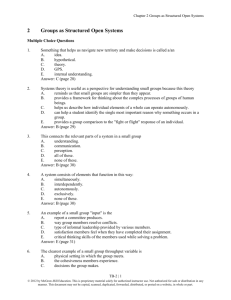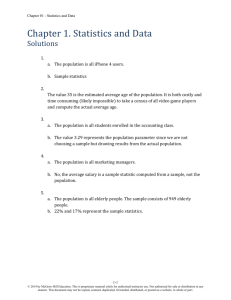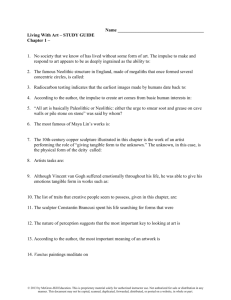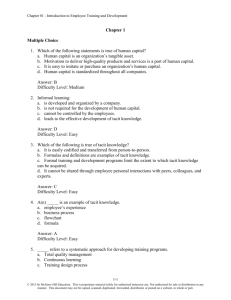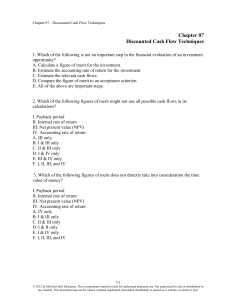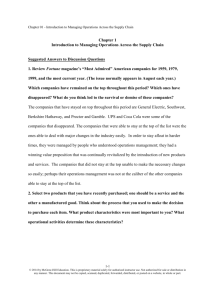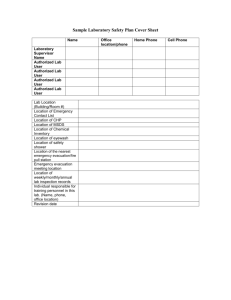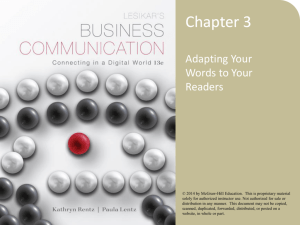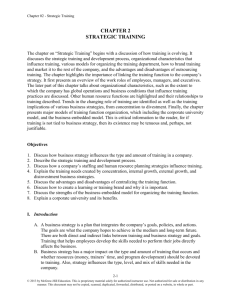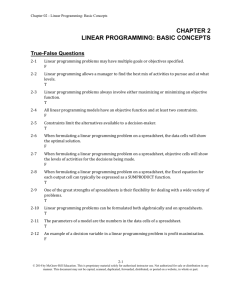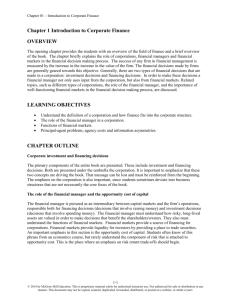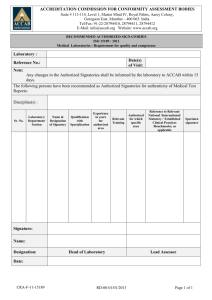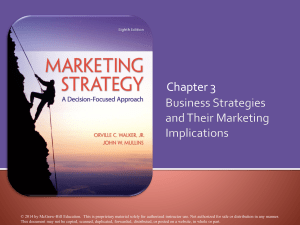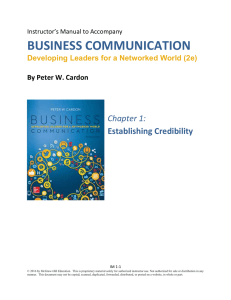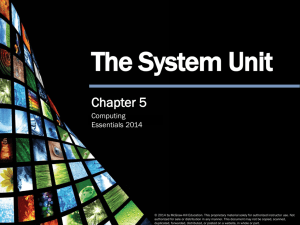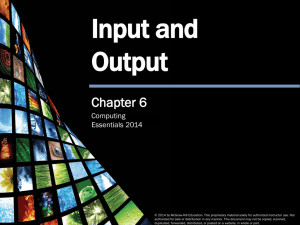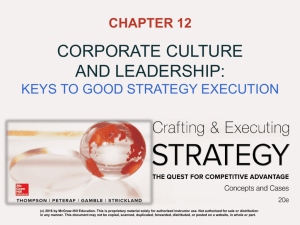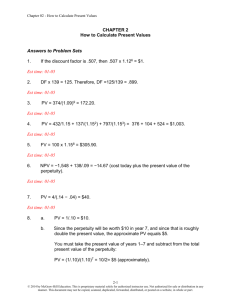FAP 21e Chapter 17 SM
advertisement
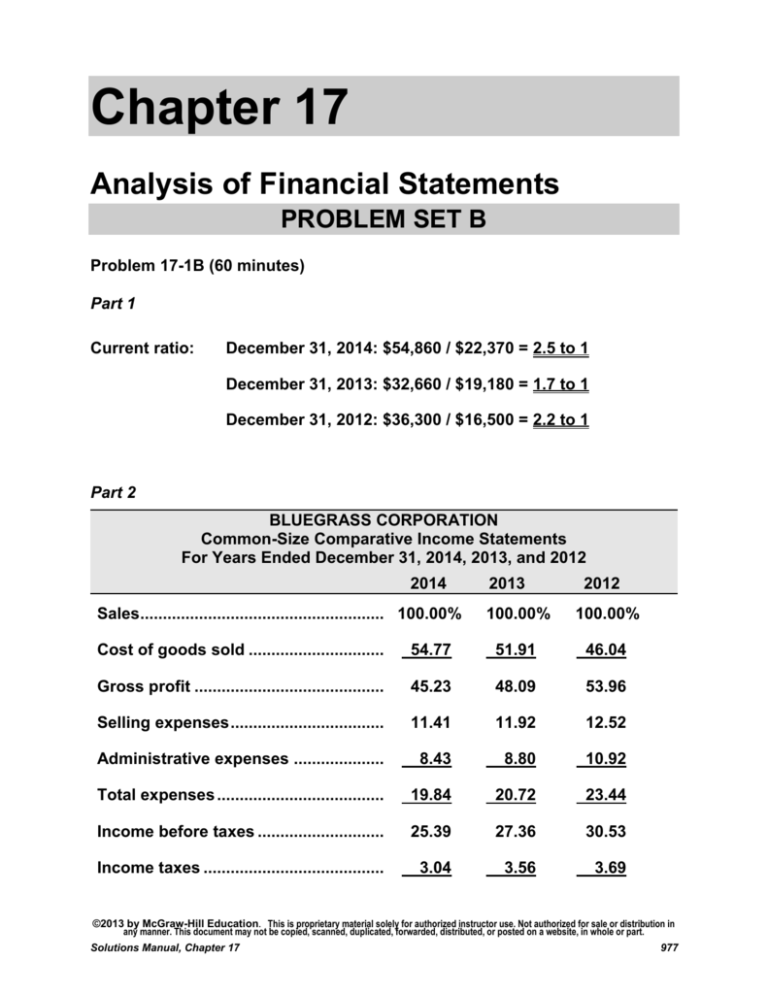
Chapter 17 Analysis of Financial Statements PROBLEM SET B Problem 17-1B (60 minutes) Part 1 Current ratio: December 31, 2014: $54,860 / $22,370 = 2.5 to 1 December 31, 2013: $32,660 / $19,180 = 1.7 to 1 December 31, 2012: $36,300 / $16,500 = 2.2 to 1 Part 2 BLUEGRASS CORPORATION Common-Size Comparative Income Statements For Years Ended December 31, 2014, 2013, and 2012 2014 Sales............................................................ 100.00% 2013 2012 100.00% 100.00% Cost of goods sold ....................................54.77 51.91 46.04 Gross profit ................................................45.23 48.09 53.96 Selling expenses ........................................11.41 11.92 12.52 Administrative expenses .......................... 8.43 8.80 10.92 Total expenses ...........................................19.84 20.72 23.44 Income before taxes ..................................25.39 27.36 30.53 Income taxes .............................................. 3.04 3.56 3.69 ©2013 by McGraw-Hill Education. This is proprietary material solely for authorized instructor use. Not authorized for sale or distribution in any manner. This document may not be copied, scanned, duplicated, forwarded, distributed, or posted on a website, in whole or part. Solutions Manual, Chapter 17 977 Net income .................................................22.34% 23.80% 26.84% * Some totals do not reconcile due to rounding. ©2013 by McGraw-Hill Education. This is proprietary material solely for authorized instructor use. Not authorized for sale or distribution in any manner. This document may not be copied, scanned, duplicated, forwarded, distributed, or posted on a website, in whole or part. 978 Fundamental Accounting Principles, 21st Edition Problem 17-1B (Concluded) Part 3 BLUEGRASS CORPORATION Balance Sheet Data in Trend Percents December 31, 2014, 2013, and 2012 2014 2013 2012 Assets Current assets ............................................ 151.13% 89.97% 100.00% Long-term investments ............................. 0.00 16.04 100.00 Plant assets ................................................ 142.80 143.87 100.00 Total assets ................................................ 133.18 117.57 100.00 Liabilities and Equity Current liabilities........................................ 135.58% 116.24% 100.00% Common stock ........................................... 125.68 125.68 100.00 Other paid in capital .................................. 122.57 122.57 100.00 Retained earnings ...................................... 139.03 112.09 100.00 Total liabilities and equity ......................... 133.18 117.57 100.00 Part 4 Significant relations revealed Bluegrass's cost of goods sold took a larger percent of sales each year. Selling and administrative expenses and income taxes took a somewhat smaller portion each year, but not enough to offset the effect of cost of goods sold. As a result, income became a smaller percent of sales each year. The large expansion of plant assets in 2013 was financed by a reduction in current assets, an increase in current liabilities, a large reduction in longterm investments, and apparently by a stock sale. One effect of this plan was to reduce the current ratio. However, the current ratio recovered in 2014. This apparently resulted from profits, limiting the amount of dividends paid, and the liquidation of long-term investments. ©2013 by McGraw-Hill Education. This is proprietary material solely for authorized instructor use. Not authorized for sale or distribution in any manner. This document may not be copied, scanned, duplicated, forwarded, distributed, or posted on a website, in whole or part. Solutions Manual, Chapter 17 979 Problem 17-2B (120 minutes) Part 1 TRIPOLY COMPANY Income Statement Trends For Years Ended December 31, 2014-2008 2014 2013 2012 2011 2010 2009 2008 Sales ..................................... 65.1% 70.9% 73.3% 79.1% 86.0% 89.5% 100.0% Cost of goods sold .............. 72.6 76.3 77.4 82.6 89.5 92.1 100.0 Gross profit .......................... 59.2 66.7 70.0 76.3 83.3 87.5 100.0 Operating expenses ............ 56.0 69.3 74.7 84.0 93.3 96.0 100.0 Net income ........................... 60.6 65.5 67.9 72.7 78.8 83.6 100.0 2010 2009 2008 TRIPOLY COMPANY Balance Sheet Trends December 31, 2014-2008 2014 Cash .................................... 2013 2012 2011 64.7% 67.6% 76.5% 79.4% 88.2% 91.2% 100.0% Accounts recble., net .......... 81.3 85.0 87.5 90.0 93.8 96.3 100.0 Merchandise inventory........ 79.8 82.7 85.6 86.5 89.4 91.3 100.0 Other current assets............ 85.0 85.0 90.0 95.0 95.0 100.0 100.0 Long-term investments ....... 32.7 27.3 23.6 100.0 100.0 100.0 100.0 Plant assets, net ..................112.3 113.2 114.5 90.7 92.5 94.3 100.0 Total assets .......................... 88.5 89.6 91.5 90.2 92.7 94.6 100.0 Current liabilities ................. 52.9 55.7 66.4 67.9 75.0 92.9 100.0 Long-term liabilities............. 35.4 46.2 54.6 56.9 74.6 82.3 100.0 Common stock .....................100.0 100.0 100.0 100.0 100.0 100.0 100.0 Other paid-in capital ............100.0 100.0 100.0 100.0 100.0 100.0 100.0 Retained earnings................166.7 157.8 145.9 137.0 122.2 103.7 100.0 Total liabilities & equity....... 88.5 89.6 91.5 90.2 92.7 94.6 100.0 ©2013 by McGraw-Hill Education. This is proprietary material solely for authorized instructor use. Not authorized for sale or distribution in any manner. This document may not be copied, scanned, duplicated, forwarded, distributed, or posted on a website, in whole or part. 980 Fundamental Accounting Principles, 21st Edition Problem 17-2B (Concluded) Part 2 Analysis and Interpretation The statements and the trend percent data show that sales declined every year. However, cost of goods sold did not fall as rapidly as sales. As a result, gross profit fell more rapidly than sales. Operating expenses fell less rapidly than gross profit, so the final result was that net income fell to 60.6% of the base year. Management was not able to reduce costs and expenses fast enough to keep up with the sales decline. Although the profits decreased during these years, the company did continue to earn a net income. It appears that the cash generated from operations was used primarily to reduce both current and long-term liabilities. The company made a large expansion of its plant assets during 2012, financing this expansion primarily through the liquidation of long-term investments. ©2013 by McGraw-Hill Education. This is proprietary material solely for authorized instructor use. Not authorized for sale or distribution in any manner. This document may not be copied, scanned, duplicated, forwarded, distributed, or posted on a website, in whole or part. Solutions Manual, Chapter 17 981 Problem 17-3B (60 minutes) Transaction Current Assets Quick Assets Current Liabilities Beginning* $300,000 $168,000 $120,000 2.50 1.40 $180,000 June 1 +120,000 +120,000 - 75,000 _______ ________ ____ ____ _______ 345,000 288,000 120,000 2.88 2.40 225,000 + 88,000 + 88,000 - 88,000 - 88,000 ________ ____ ____ _______ 345,000 288,000 120,000 2.88 2.40 225,000 +150,000 ________ +150,000 ____ ____ _______ Bal. June 3 Bal. June 5 Bal. June 7 Bal. June 10 Bal. June 12 Bal. June 15 Bal. Current Acid-Test Ratio Ratio Working Capital 495,000 288,000 270,000 1.83 1.07 225,000 +100,000 +100,000 +100,000 ____ ____ _______ 595,000 388,000 370,000 1.61 1.05 225,000 +120,000 +120,000 _______ ____ ____ _______ 715,000 508,000 370,000 1.93 1.37 345,000 - 275,000 - 275,000 ________ ____ ____ _______ 440,000 233,000 370,000 1.19 0.63 70,000 ________ ________ + 80,000 ____ ____ _______ 440,000 233,000 450,000 0.98 0.52 (10,000) +0 +0 ________ ____ ____ _______ 440,000 233,000 450,000 0.98 0.52 (10,000) - 12,000 - 12,000 - 12,000 ____ ____ _______ 428,000 221,000 438,000 0.98 0.50 (10,000) June 30 - 80,000 - 80,000 - 80,000 ____ ____ _______ Bal. $348,000 $141,000 $358,000 0.97 0.39 (10,000) June 19 Bal. June 22 Bal. *Beginning balances Current assets (given) ............................................ $300,000 Current liabilities ($300,000 / 2.50)......................... 120,000 Quick assets ($120,000 x 1.40) ............................... 168,000 ©2013 by McGraw-Hill Education. This is proprietary material solely for authorized instructor use. Not authorized for sale or distribution in any manner. This document may not be copied, scanned, duplicated, forwarded, distributed, or posted on a website, in whole or part. 982 Fundamental Accounting Principles, 21st Edition Problem 17-4B (50 minutes) 1. Current ratio $6,100 + $6,900 + $12,100 + $3,000 + $13,500 + $2,000 = 2.5 to 1 $11,500 + $3,300 + $2,600 2. Acid-test ratio $6,100 + $6,900 + $12,100 + $3,000 $11,500 + $3,300 + $2,600 3. = 1.6 to 1 Days' sales uncollected $12,100 + $3,000 x 365 = 17.5 days $315,500 4. Inventory turnover $236,100 = 15.3 times ($13,500 + $17,400)/2 5. Days’ sales in inventory $13,500 x 365 = 20.9 days $236,100 6. Debt-to-equity ratio ($11,500 + $3,300 + $2,600 + $30,000) / ($35,000 + $35,100) = 0.68 to 1 7. Times interest earned $30,200 / $2,200 = 13.73 times 8. Profit margin ratio $23,800 = 7.5% $315,500 ©2013 by McGraw-Hill Education. This is proprietary material solely for authorized instructor use. Not authorized for sale or distribution in any manner. This document may not be copied, scanned, duplicated, forwarded, distributed, or posted on a website, in whole or part. Solutions Manual, Chapter 17 983 Problem 17-4B (Concluded) 9. Total asset turnover $315,500 = 3.0 times ($117,500 + $94,900)/2 10. Return on total assets $23,800 = 22.4% ($117,500 + $94,900)/2 11. Return on common stockholders' equity $23,800 ($70,100 + $54,300)/2 = 38.3% ©2013 by McGraw-Hill Education. This is proprietary material solely for authorized instructor use. Not authorized for sale or distribution in any manner. This document may not be copied, scanned, duplicated, forwarded, distributed, or posted on a website, in whole or part. 984 Fundamental Accounting Principles, 21st Edition Problem 17-5B (60 minutes) Part 1 Fargo Company Ball Company a. Current ratio $205,200 = 2.3 to 1 $90,500 $208,100 = 2.1 to 1 $97,000 $108,700 = 1.2 to 1 $90,500 $116,000 = 1.2 to 1 $97,000 b. Acid-test ratio c. Accounts (and notes) receivable turnover $393,600 = 4.9 times ($77,100 + $11,600 + $72,200)/2 $667,500 = 8.7 times ($70,500 + $9,000 + $73,300)/2 d. Inventory turnover $290,600 = 3.0 times ($86,800 + $105,100)/2 $480,000 ($82,000 + $80,500)/2 = 5.9 times e. Days’ sales in inventory $86,800 x 365 = 109.0 days $290,600 $82,000 $480,000 x 365 = 62.4 days f. Days' sales uncollected $77,100 + $11,600 x 365 = 82.3 days $393,600 $70,500 + $9,000 x 365 = 43.5 days $667,500 Short-term credit risk analysis: Fargo and Ball have nearly equal current ratios and equal acid-test ratios. However, Ball both turns its merchandise and collects its accounts receivable much more rapidly than Fargo. On this basis, Ball probably is the better short-term credit risk. ©2013 by McGraw-Hill Education. This is proprietary material solely for authorized instructor use. Not authorized for sale or distribution in any manner. This document may not be copied, scanned, duplicated, forwarded, distributed, or posted on a website, in whole or part. Solutions Manual, Chapter 17 985 Problem 17-5B (Concluded) Part 2 Fargo Company Ball Company a. Profit margin ratio $33,850 = 8.6% $393,600 $61,700 $667,500 = 9.2% b. Total asset turnover $393,600 ($382,100 + $383,400)/2 = 1.03 times $667,500 = 1.48 times ($460,400 + $443,000)/2 c. Return on total assets $33,850 ($382,100 + $383,400)/2 = 8.8% $61,700 = 13.7% ($460,400 + $443,000)/2 d. Return on common stockholders' equity $33,850 ($198,600 + $182,100)/2 = 17.8% $61,700 ($270,100 + $250,700)/2 = 23.7% e. Price-earnings ratio $25 = 19.7 $1.27 $25 = 11.4 $2.19 f. Dividend yield $1.50 = 6.0% $25 $1.50 = 6.0% $25 Investment analysis: Ball’s profit margin, total asset turnover, return on total assets, and return on common stockholders' equity are all higher than Fargo's. Also, Ball has a lower price-earnings ratio, while paying the same dividend. These factors indicate that Ball stock is likely the better investment. ©2013 by McGraw-Hill Education. This is proprietary material solely for authorized instructor use. Not authorized for sale or distribution in any manner. This document may not be copied, scanned, duplicated, forwarded, distributed, or posted on a website, in whole or part. 986 Fundamental Accounting Principles, 21st Edition Problem 17-6BA (60 minutes) Part 1 Effect of income taxes (debits or losses in parentheses) Pretax 25% Tax Effect After-Tax e. Loss on hurricane damage...................................................... (64,000) (16,000) (48,000) l. Loss from operating a discontinued segment......................... (120,000) (30,000) (90,000) n. Correction of overstatement of prior year’s expense............. 48,000 12,000 36,000 p. Loss on sale of discontinued segment’s assets ..................... (180,000) (45,000) (135,000) Part 2 Income from continuing operations (and its components) c. Net sales ......................................................................... $2,640,000 b. Interest revenue ............................................................. 20,000 j. Gain from settling lawsuit ............................................. 68,000 Total revenues and gains ............................................. 2,728,000 o. Cost of goods sold ........................................................ $1,040,000 h. Depreciation expense—Equipment ............................. 100,000 m. Depreciation expense—Buildings ............................... 156,000 g. Other operating expenses ............................................ 328,000 k. Loss on sale of equipment ........................................... 24,000 i. Loss from settling lawsuit ............................................ 36,000 d. Total expenses and losses ........................................... 1,684,000 Income from continuing operations before taxes ............ 1,044,000 Income taxes expense (25%) ........................................ Income from continuing operations after taxes ............... (261,000) $ 783,000 ©2013 by McGraw-Hill Education. This is proprietary material solely for authorized instructor use. Not authorized for sale or distribution in any manner. This document may not be copied, scanned, duplicated, forwarded, distributed, or posted on a website, in whole or part. Solutions Manual, Chapter 17 987 Problem 17-6BA (Concluded) Part 3 Income from discontinued segment l. Loss from operating a discontinued segment (after-tax)..................$ (90,000) p. Loss on sale of discontinued segment’s assets (after-tax) .............. (135,000) Loss from discontinued segment ................................................$(225,000) Part 4 Income before extraordinary items Income from cont. operations after taxes (from Part 2) ................. $ 783,000 Loss from discontinued segment (from Part 3) ..............................(225,000) Income before extraordinary items ............................................. $ 558,000 Part 5 Net income Income before extraordinary items ............................................. $ 558,000 Extraordinary item: e. Loss on hurricane damage (after-tax) ......................................... (48,000) Net income ..................................................................................... $ 510,000 ©2013 by McGraw-Hill Education. This is proprietary material solely for authorized instructor use. Not authorized for sale or distribution in any manner. This document may not be copied, scanned, duplicated, forwarded, distributed, or posted on a website, in whole or part. 988 Fundamental Accounting Principles, 21st Edition
